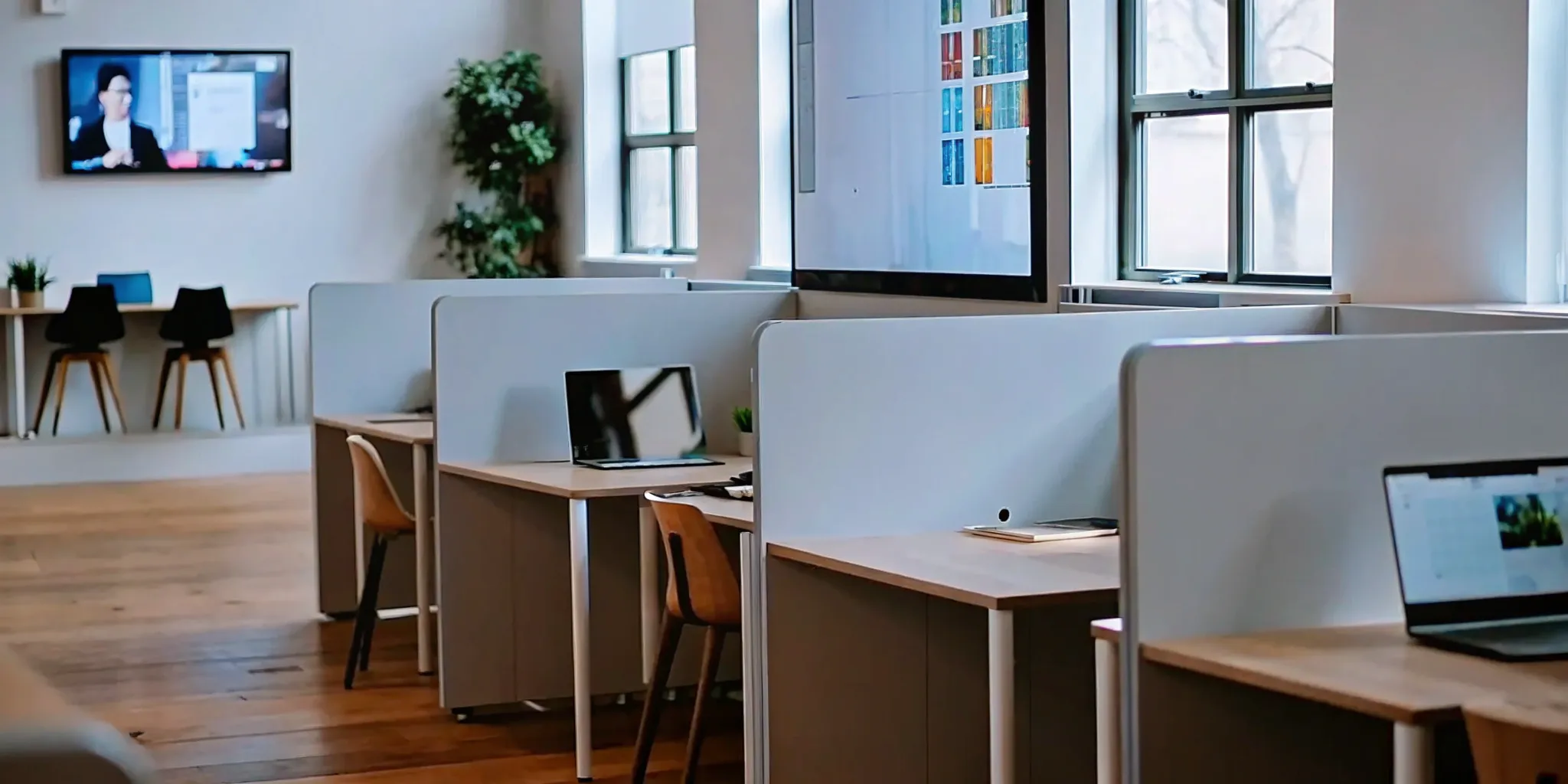Working in a flexible environment has become increasingly popular in recent years. Gone are the days of being chained to a cubicle, as employees can now choose when, where, and how they work. This freedom brings with it a plethora of benefits for both individuals and organizations. In this article, we will delve into the concept of flexible work environments, explore their impact on employee well-being, discuss strategies to maximize well-being in these settings, and examine the challenges and future of this flexible movement.
Understanding the Concept of Flexible Work Environments
What exactly is a flexible work environment? It is more than just allowing employees to work from home or outside the traditional 9-to-5 office hours. It is about redefining the boundaries between work and personal life and empowering individuals to design their own work schedules. Flexible work environments can encompass remote work, flextime, compressed workweeks, and job sharing, among other arrangements.
Defining Flexible Work Environments
Flexible work environments are all about giving employees the autonomy to choose when and where they work, as long as they meet their job requirements. It is a departure from the rigid structures of traditional workplaces, where productivity was measured by the number of hours spent at the office rather than the quality of work produced.
Imagine a world where employees have the freedom to work from their favorite coffee shop, a cozy corner in their home, or even while traveling to exotic destinations. This level of flexibility allows individuals to create a work environment that suits their unique needs and preferences. Some may thrive in the tranquility of a home office, while others may find inspiration in the bustling atmosphere of a local cafe.
Moreover, flexible work environments promote a healthy work-life balance. By enabling employees to design their own work schedules, they can allocate time for personal commitments, such as attending their child's school events, pursuing hobbies, or simply taking a well-deserved break. This balance contributes to increased job satisfaction and overall well-being.
The Evolution of Workplace Flexibility
The concept of flexible work environments has evolved over time. Initially, it was seen as a perk offered by progressive companies to attract and retain talent. However, with advancements in technology and changing attitudes toward work-life balance, the traditional 9-to-5 model has become less prevalent.
In the past, the idea of working remotely seemed like a distant dream. However, with the advent of high-speed internet, video conferencing tools, and cloud-based collaboration platforms, it has become a viable option for many industries. Employees can now seamlessly connect with colleagues and clients from different parts of the world, breaking down geographical barriers and fostering global collaboration.
Today, the COVID-19 pandemic has accelerated the adoption of flexible work environments, with companies worldwide embracing remote work as the new normal. This shift has demonstrated that productivity does not necessarily rely on physical presence in the office, opening the door for even greater flexibility in the future.
As organizations adapt to this new way of working, they are discovering the numerous benefits of flexible work environments. Reduced commuting time and costs, increased employee satisfaction and engagement, and improved work-life integration are just a few of the advantages that companies are experiencing. Furthermore, flexible work arrangements can also contribute to a more diverse and inclusive workforce, as they provide opportunities for individuals with different abilities, caregiving responsibilities, or geographical constraints.
Looking ahead, the concept of flexible work environments will continue to evolve. As technology advances and societal norms shift, new possibilities will emerge, allowing individuals to customize their work experiences even further. The future of work is undoubtedly flexible, empowering employees to achieve their professional goals while maintaining a fulfilling personal life.
The Impact of Flexible Work Environments on Employee Well-being
Flexible work environments have a profound impact on employee well-being, both psychologically and physically. Let's explore these benefits in more detail.
When it comes to the psychological benefits of flexibility, the impact cannot be overstated. Flexibility in work arrangements can reduce stress levels and enhance overall mental well-being. When employees have control over their work schedule, they experience greater job satisfaction and a sense of empowerment. This, in turn, leads to increased motivation, productivity, and creativity.
Imagine a scenario where an employee has the flexibility to start their workday a bit later to accommodate their personal needs. This freedom allows them to start their day feeling refreshed and ready to tackle their tasks. As a result, they are more likely to approach their work with a positive mindset, leading to higher quality output and a sense of fulfillment.
Furthermore, flexible work environments foster a healthier work-life balance, allowing individuals to spend more time with their families and engage in personal pursuits. This improved harmony between work and personal life contributes to greater overall happiness and satisfaction. Employees who have the flexibility to attend their child's school events or take care of personal errands during the day feel a sense of fulfillment in both their personal and professional lives.
Now, let's shift our focus to the physical health benefits of flexible work environments. By eliminating commuting time and office-based sedentary routines, employees have the opportunity to incorporate more physical activity into their daily lives. Whether it's going for a midday jog or practicing yoga during lunch breaks, these active pursuits promote better physical well-being.
Imagine a scenario where an employee has the flexibility to work from home a few days a week. Instead of spending hours in traffic, they can utilize that time to engage in physical activities that they enjoy. This not only improves their physical health but also boosts their mood and energy levels, leading to increased productivity when they do sit down to work.
Moreover, flexible work arrangements can also reduce exposure to illnesses and contagious diseases. By working remotely, employees can minimize the risk of contracting illnesses from colleagues, which is particularly relevant in the context of the COVID-19 pandemic. This added layer of protection allows employees to focus on their work without the constant worry of falling ill.
Imagine a scenario where an employee has the flexibility to work from home during flu season. By avoiding the office environment, they significantly reduce their chances of coming into contact with contagious germs. This not only benefits the individual but also helps maintain a healthy workforce, as fewer employees falling sick means fewer disruptions to the workflow.
In conclusion, flexible work environments have far-reaching benefits for employee well-being. From the psychological advantages of reduced stress and improved work-life balance to the physical benefits of increased physical activity and reduced exposure to illnesses, flexibility empowers employees to thrive both personally and professionally.
Strategies to Maximize Well-being in Flexible Work Environments
While flexible work environments offer numerous benefits, it is essential to establish strategies to maximize well-being within these setups. Here are some tips:
Creating a Balance between Work and Personal Life
When working flexibly, it is crucial to establish clear boundaries between work and personal life. Set designated work hours and create a dedicated workspace that separates professional and personal activities. This way, you can fully immerse yourself in work during designated hours and disconnect once work is done.
Additionally, make time for self-care activities, such as exercise, hobbies, and quality time with loved ones. Prioritizing your well-being outside of work is key to achieving a healthy work-life balance.
For instance, incorporating regular exercise into your routine can have a significant impact on your overall well-being. Engaging in physical activities like yoga, running, or even taking a walk during your lunch break can help reduce stress levels and improve focus and productivity. It also promotes better sleep, boosts mood, and increases energy levels.
Moreover, dedicating time to pursue hobbies and interests outside of work can provide a much-needed break and help you recharge. Whether it's painting, playing a musical instrument, or reading, engaging in activities that bring you joy and relaxation can contribute to your overall well-being.
Encouraging Healthy Work Habits
Without the structure of a traditional office environment, it can be easy to fall into unhealthy work habits. To combat this, establish a routine that includes regular breaks, proper meal times, and sufficient rest. Avoid the temptation to work long hours without breaks, as this can lead to burnout and decreased productivity.
Furthermore, maintain open communication with your colleagues and supervisors to ensure that expectations and deliverables are clear. By setting realistic goals and managing workload effectively, you can prevent stress and maintain a healthy work environment.
In addition to regular breaks, it is important to incorporate mindfulness practices into your workday. Taking short moments to pause, breathe, and refocus can help reduce stress and increase mental clarity. Mindfulness techniques such as meditation or deep breathing exercises can be easily integrated into your flexible work routine, allowing you to stay present and focused on your tasks.
Another crucial aspect of maintaining well-being in a flexible work environment is ensuring proper nutrition. It can be tempting to skip meals or rely on unhealthy snacks when working from home. However, by planning and preparing nutritious meals and snacks in advance, you can fuel your body and mind for optimal performance. Consider meal prepping or having healthy snacks readily available to avoid the temptation of reaching for unhealthy options.
Lastly, don't underestimate the power of rest and relaxation. Adequate sleep is vital for overall well-being and productivity. Establish a consistent sleep schedule and create a relaxing bedtime routine to ensure quality rest. Disconnect from electronic devices before bed and create a sleep-friendly environment that promotes relaxation and rejuvenation.
By implementing these strategies, you can maximize your well-being in a flexible work environment. Remember, prioritizing self-care, establishing boundaries, and fostering healthy work habits are key to thriving in a flexible work setup.
Challenges in Implementing Flexible Work Environments
While flexible work environments offer numerous advantages, they are not without challenges. Let's explore some common obstacles and how to overcome them.
Overcoming Isolation in Remote Work
Remote work can sometimes lead to feelings of isolation and disconnection. To combat this, it's important to foster a sense of community and camaraderie among remote team members. Regular virtual team meetings, informal chats, and team-building activities can help maintain social connections and promote a positive work culture.
Additionally, consider joining remote work communities or online forums where you can connect with like-minded individuals facing similar challenges. These platforms provide opportunities for networking, sharing experiences, and seeking support.
Managing Time and Productivity in Flexible Work
Managing time and productivity in a flexible work environment can be a challenge, as distractions and competing priorities may arise. To optimize productivity, establish a structured daily routine and set clear goals for each day or week.
Use time management techniques such as the Pomodoro Technique, which involves working in focused bursts followed by short breaks. This can help you stay focused and maintain a healthy work pace.
The Future of Flexible Work Environments
As we look ahead, it is clear that the future of work is flexible. Let's explore some predicted trends and the role of technology in shaping flexible work environments.
Predicted Trends in Workplace Flexibility
Remote work is here to stay, and it is expected to become even more prevalent in the coming years. Companies are realizing the benefits of flexible work arrangements, both in terms of employee satisfaction and cost savings.
Furthermore, flexible work environments are likely to extend beyond traditional office-based roles. Industries such as healthcare, education, and manufacturing are exploring ways to incorporate flexibility into their operations, allowing employees in diverse fields to enjoy the benefits of this movement.
The Role of Technology in Shaping Flexible Work Environments
Technology plays a crucial role in enabling and enhancing flexible work environments. The availability of collaboration tools, project management software, and virtual communication platforms allows employees to seamlessly collaborate regardless of their physical location.
As technology continues to advance, we can expect even more innovative solutions that will further enhance the flexibility and efficiency of remote work. From virtual reality meetings to artificial intelligence-powered project management, the possibilities are endless.
In conclusion, maximizing well-being in flexible work environments is not only possible but essential. By understanding the concept of flexible work, harnessing its psychological and physical benefits, implementing effective strategies, overcoming challenges, and embracing the future of work, individuals and organizations can create environments that promote productivity, happiness, and overall well-being.






.webp)








.svg)